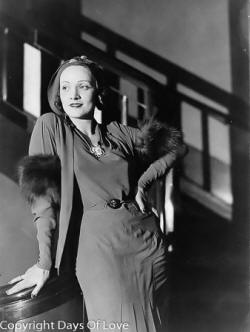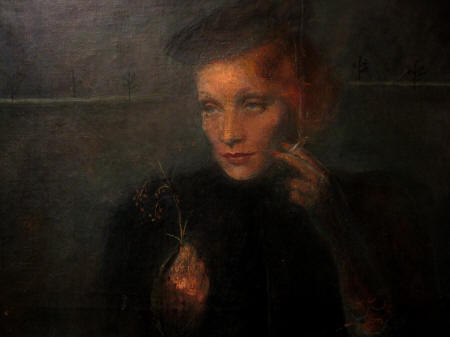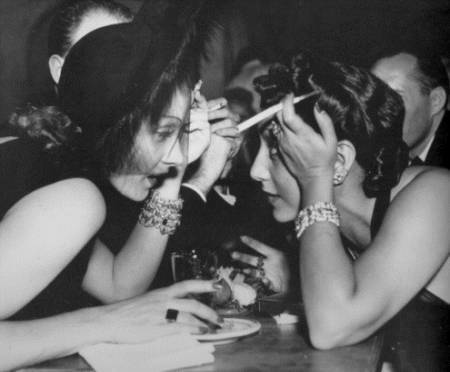

Queer Places:
Leberstraße 65, 10829 Berlin, Germany
The Savoy, Strand, London WC2R 0EU, Regno Unito
Claridge's, Brook Street, Mayfair, London W1K 4HR, Regno Unito
993 Park Ave, New York, NY 10028, USA
Friedhof Schöneberg III, 12161 Berlino, Germania
 Marie
Magdalene "Marlene" Dietrich (27 December 1901 – 6 May 1992)[1]
was a German actress and singer who held both German and American citizenship.[2][3][4]
In her 1960 autobiography, Here Lies the Heart,
Mercedes De Acosta claimed
to have been intimate with
Isadora Duncan,
Marlene Dietrich,
Alice B. Toklas,
Marie Laurencin,
Eva Le Gallienne,
Malvina Hoffman
and
Greta Garbo. Dietrich has been romantically linked
also to Édith Piaf,
Greta Garbo,
Claire Waldoff,
Tallulah Bankhead,
Claudette Colbert,
Barbara Stanwyck, Denise Parker,
Ginette Spanier,
Anna May Wong.
Marie
Magdalene "Marlene" Dietrich (27 December 1901 – 6 May 1992)[1]
was a German actress and singer who held both German and American citizenship.[2][3][4]
In her 1960 autobiography, Here Lies the Heart,
Mercedes De Acosta claimed
to have been intimate with
Isadora Duncan,
Marlene Dietrich,
Alice B. Toklas,
Marie Laurencin,
Eva Le Gallienne,
Malvina Hoffman
and
Greta Garbo. Dietrich has been romantically linked
also to Édith Piaf,
Greta Garbo,
Claire Waldoff,
Tallulah Bankhead,
Claudette Colbert,
Barbara Stanwyck, Denise Parker,
Ginette Spanier,
Anna May Wong.
Throughout her long career, (which spanned from the 1910s to the 1980s) Dietrich maintained popularity by continually reinventing herself.[5]
Unlike her professional celebrity, which was carefully crafted and maintained, Dietrich's personal life was kept out of public view. She was fluent in German, English, and French. Dietrich, who was bisexual, quietly enjoyed the thriving gay scene of the time and drag balls of 1920s Berlin.[79][80] She also defied conventional gender roles through her boxing at Turkish trainer and prizefighter Sabri Mahir’s boxing studio in Berlin, which opened to women in the late 1920s. As Austrian writer Hedwig (Vicki) Baum recalls in her memoir, "I don't know how the feminine element sneaked into those masculine realms [the boxing studio], but in any case, only three or four of us were tough enough to go through with it (Marlene Dietrich was one)."[81]
In 1920s Berlin, Dietrich acted on the stage and in silent films.

LILLIAN COTTON
"PORTRAIT OF MARLENE DIETRICH"
OIL ON CANVAS, SIGNED
AMERICAN, C.1930S
40 X 30 INCHES

Marlene Dietrich by Martin Kosleck

Marlene Dietrich and Ann Warner, 1939, by Jean Howard
The Savoy, London
Stadtischer Friedhof III, Berlin, Germany
Dietrich was married only once, to assistant director Rudolf Sieber, who later became an assistant director at Paramount Pictures in France, responsible for foreign language dubbing. Dietrich's only child, Maria Riva, was born in Berlin on 13 December 1924. She would later become an actress, primarily working in television. When Maria gave birth to a son (John, later a famous production designer) in 1948, Dietrich was dubbed "the world's most glamorous grandmother". After Dietrich's death, Riva published a frank biography of her mother, titled Marlene Dietrich (1992).[82]
In 1925 she is in The Joyless Street filmed in Berlin with Greta Garbo. In her old age, Dietrich, before always denying it, confirmed that also she was in the movie. She admitted it to her British late-life friend and biographer David Bret, an expert on the Berlin nightlife of her era. She is "Maria's friend", an unbilled black-haired young woman to whom others later gave other names.
Greta Garbo has been commonly regarded as Dietrich's greatest film rival, but there is also a rumor of an affair between them. This rumor had its highlight in 2000 when writer Diana McLellan released her book The Girls: Sappho goes to Hollywood. The author wrote that, in her research, she found proof of a never-before-reported affair between Garbo and Dietrich. She wrote that they met in Berlin in 1925 while Garbo was filming The Joyless Street and Dietrich had a minor part in the film. Dietrich confirmed that she was indeed in The Joyless Street with Garbo. She admitted it to her British late-life friend and biographer David Bret, an expert on the Berlin nightlife of her era. The two enemies shared the most intimate friends, without so much as a word passing between them or speaking each other's names in public. Finally, in the summer of 1945, when Dietrich was the guest of Orson Welles and his wife Rita Hayworth at their house in Los Angeles, she decided it was time to attempt a reconciliation with Garbo. Dietrich persuaded Welles to invite Garbo to a dinner hosted by Clifton Webb, and Garbo accepted. Welles presented the two women to each other, and promptly Dietrich swarmed around Garbo and told her how inspiring she was, calling Garbo goettlich (divine) and an unsterbliche (undying) muse.[95] Dietrich was evidently unimpressed by Garbo remarking to Welles, "It's not true that she doesn't wear makeup. She had her eyelashes beaded. Do you know how long it takes to have your eyelashes beaded?" They are alleged to have met one last time in New York, when Dietrich, dressed as a nurse to remain incognito, was with her grandson in Central Park. Garbo is supposed to have admired the baby and not recognized Dietrich.
Dietrich's performance as Lola-Lola in The Blue Angel (1930) brought her international fame and a contract with Paramount Pictures. At the German premiere, she walked out onto the stage with a bunch of violets pinned to the crotch of her gown. Violets, the symbol of lesbianism, sure to be understood by an audience of her friends in Berlin.
Dietrich starred in Hollywood films such as Morocco (1930), Shanghai Express (1932), and Desire (1936). She successfully traded on her glamorous persona and "exotic" looks, and became one of the highest-paid actresses of the era. Throughout World War II, she was a high-profile entertainer in the United States. Although she still made occasional films after the war, Dietrich spent most of the 1950s to the 1970s touring the world as a marquee live-show performer.
Throughout her career, Dietrich had an unending string of affairs, some short-lived, some lasting decades. They often overlapped and were almost all known to her husband, to whom she was in the habit of passing the love letters from her men, sometimes with biting comments.[83] When Dietrich arrived in Hollywood and filmed Morocco (1930), she had an affair with Gary Cooper, even though he was already having an affair with Mexican actress Lupe Vélez.[84] Vélez once said, "If I had the opportunity to do so, I would tear out Marlene Dietrich's eyes."[85] Another of her famous affairs was John Gilbert, famous for his alleged affair with Greta Garbo. Gilbert's untimely death was one of the most painful events of her life.[86] Dietrich also had a brief affair with Douglas Fairbanks Jr., even though he was married to Joan Crawford.[87] At the filming of Destry Rides Again, Dietrich started a love affair with co-star James Stewart, which ended after filming.
In June 1935, Carole Lombard threw a party, a rather infamous one, as it turned out, at an amusement park in Venice Beach. The guest list as reported in the press was made uo predominately of "sophisticated" types, especially the women, Lombard invited girls with spunk, irreverence, "imagination": Marlene Dietrich, Lili Damita, Josephine Hutchinson (lover of Eva LeGallienne), Claudette Colbert. The Associated Press was there to take pictures, and noted that the gala, lasting into the wee hours of the morning, was deemed by Hollywood "the most unique in years". Certainly the photos caused a stir, especially the one of Colbert nestled between Dietrich's legs as they slid down a chute together. Later, after Colbert's death, her companion, Helen O’Hagan, with whom she'd lived for more than 20 years, would tell reporters that Claudette barely knew Dietrich, despite the fact that they were Paramount stars on the lot at the same time. Friend Leonard Gershe insisted that Claudette told him "some photographer pushed her" onto the slide with Dietrich. And besides, Gershe insisted, "Marlene and Claudette didn't even like each other. Dietrich described her as "that ugly Claudette Colbert, so shopgirl French."" Yet the photographs of Jerome Zerbe, taken roughly at the same time as Lombard's party, reveal these two supposed foes very close and friendly. Indeed, other friends recall the Dietrich-Colbert connection quite differently. "Maybe they became unfriendly later, but I'm quite sure they were lovers for a time before Claudette married second husband Jack Pressman", said the writer Robert Shaw, who became close with Colbert in the 1950s. "I know Claudette adored Dietrich. I used to kid Claudette about her all the time."
The gay scene was documented in the 1930s by Jerome Zerbe, who spent "three gay months" (his words) in the movie colony. Fascinating are his many photos of Cary Grant and Randolph Scott, attesting to their involvement in the gay scene: Scott arriving at a party at Zerbe's apartment, several lovely poses of Grant in a bathing suit. Zerbe's photographs of the Countess Dorothy di Frasso's party in the summer of 1935, however, remain the most intriguing. The writer Brendan Gill would recount a tale as told to him by Zerbe, in which the countess, known for her malicious sense of humor, secured recording devices to the undersides of all her garden benches. On the day of her party, the wily countess nailed some pretty incriminating tales from her unsuspecting guests. Zerbe's photographs documented the party, and reveal the guests to have all been part of the "sophisticated" clique. Although Cary Grant arrived with perennial date Betty Furness, he posed jauntily with William Haines, George Cukor, and Clifton Webb; Claudette Colbert mugged playfully next to Marlene Dietrich, refuting for posterity charges that they barely knew each other. In one shot, Zerbe captured Colbert taking home movie of Dietrich. A few weeks later, the countess invited the same group back for another party. Gill reported: "She played back for them the indiscreet conversations they had carried on in the supposed privacy of the garden. The prank was not well received." Indeed Photoplay's pseudonymous "Cal York" (perhaps at this point the gay writer Jerry Asher) reported that di Frasso received five urgent (York's emphasis) pleadings from unnamed persons to not play the recordings at her next party, or ever again.
In 1936 Marlene Dietrich was in Paris for the opening of a new Maurice Chevalier musical at the Casino de Paris. Erich Maria Remarque, an ex-beau of Dietrich, also came to the show and the reception afterwards. His date for the evening was a 20-year-old woman, Frederique Baule. But it was Dietrich that left with Frede, as she preferred to be known, spent much of the next few years with Marlene who kept returning to Paris as often as her Hollywood career would allow. In 1938 Marlene set Frede up in business with a nightclub that was officially called La Silhouette (after Marlene's favourite bar in Berlin), but was generally known as Chez Frede. It catered to lesbians and cross-dressing women, but also to celebrities. Frede's dress and haircut became quite masculine. Errol Flynn describes her in his autobiography: "She dressed better than any man I had ever seen. … her over-all effect that of a sophisticated English schoolboy. Her man's haircut looked better on her than on any man." Apparently La Silhouette was able to stay open during the German occupation. The club did did so well that in the late 1940s Frede moved to a larger place, Carroll's. Marlene of course was present for the opening, and also Erich Maria Remarque and Maurice Chevalier.
In 1937 Joe Carstairs met Marlene Dietrich in the south of France. They had an affair, which they had to keep secret from Dietrich’s then lover, the novelist Erich Maria Remarque; he portrayed Carstairs as a man in The Arch of Triumph. At one point Carstairs gave Dietrich a beach.
In 1938, Dietrich met and began a relationship with writer Erich Maria Remarque, and in 1941, the French actor and military hero Jean Gabin. Their romance began when both were supporting the Allied troops in World War II. The relationship ended in the mid-1940s.
In the early 1940s, Dietrich also had an affair with John Wayne, her co-star in two films. Dietrich had a strong friendship with Orson Welles, who for her was a kind of platonic love and whom she considered a genius.[88] She also had an affair with Cuban-American writer Mercedes de Acosta, who claimed to be Greta Garbo's lover. Sewing circle was a phrase used by Dietrich[89] to describe the underground, closeted lesbian and bisexual film actresses and their relationships in Hollywood.
Dietrich was noted for her humanitarian efforts during the war, housing German and French exiles, providing financial support and even advocating their US citizenship. For her work on improving morale on the front lines during the war, she received several honors from the United States, France, Belgium, and Israel. In 1999, the American Film Institute named Dietrich the ninth-greatest female star of classic Hollywood cinema.[6]
In the supposed "Marlene's Sewing Circle" [90] are mentioned the names of other close friends such as Ann Warner (the wife of Jack L. Warner, one of the owners of the Warner studios), Lili Damita (an old friend of Marlene's from Berlin and the wife of Errol Flynn), Claudette Colbert,[91] and Dolores del Río (whom Dietrich considered the most beautiful woman in Hollywood).[92][93] The French singer Edith Piaf was also one of Dietrich's closest friends during her stay in Paris in the 1950s, and there were always rumors of something more than friendship between them.[94]
In one of her last interviews, in the early 1990s, the Paris Match magazine asked Dietrich who are, beside her, the biggest movie legends of all time. She named Garbo, Marilyn Monroe, and Rita Hayworth.[96] Her last great passion, when Dietrich was in her 50s, appears to have been for the actor Yul Brynner, with whom she had an affair that lasted more than a decade; her love life continued well into her 70s. She counted Errol Flynn,[97] George Bernard Shaw, John F. Kennedy, Michael Wilding, and Frank Sinatra among her conquests.[98] Dietrich maintained her husband and his mistress first in Europe and later on a ranch in the San Fernando Valley, near Hollywood.
Dietrich's family brought her up to follow the Lutheran religion, but she abandoned it as a result of her experiences as a teenager during World War I, after hearing preachers from both sides invoking God as their support. "I lost my faith during the war and can't believe they are all up there, flying around or sitting at tables, all those I've lost."[99] Quoting Goethe in her autobiography, she wrote, "If God created this world, he should review his plan."[100] However, according to her daughter, Maria Riva, Dietrich always travelled with a satchel containing many religious medallions (St. Christopher, etc.), showing her desire to keep her faith.[101] Also, during her reclusive twilight years in Paris, Dietrich allegedly converted to and strongly embraced Roman Catholicism but this hasn't been well corroborated.[102] On 14 May 1992, her funeral ceremony was performed at her favorite Paris church, La Madeleine.[51]
My published books: